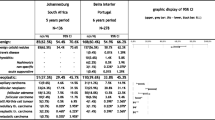Abstract
Despite the observation that parity may increase the risk of thyroid carcinoma, very few studies have investigated the possible repercussion of parity on thyroid benign pathology. Recently, parity has been identified as one of the factors contributing to a larger thyroid size in healthy females. The aim of this work was to investigate a possible role for parity on the prevalence of multinodular goiter in iodine deficient areas. For this purpose, the reproductive histories of 2 cohorts of women, normal (Group I, 235 cases) and non-toxic multinodular goiter (NTMNG) affected (Group II, 274 cases) were compared. All subjects were euthyroid and had no previous history of thyroid function abnormalities. The number of full-term previous pregnancies (2.55±0.11 vs 1.77±0.10) and age (47.7±0.76 vs 42.3±0.83 yr) were found significantly higher (p<0.001) in multinodular goiter (MNG) patients than controls. Parity and age were found to be directly correlated (p<0.001), nevertheless the partial correlation coefficients demonstrated an independent and statistically significant difference for both variables between normal and NTMNG. Therefore, the independent effects of parity and age were further investigated. The effect of age on NTMNG prevalence seems to be weaker, in fact significant differences (p≪0.001) for age between patients and controls were detected only when the effect of parity was absent (nulliparous), while with increasing gestations the effect of age disappeared. Our results indicate that age plays a minor role compared to parity which can therefore be considered as a stronger risk factor. In conclusion, the present study shows that, at least in iodine deficient regions, non-toxic multinodular goiter women show a statistically significant higher parity rate than healthy controls. Age may play a certain role but only when additional stronger risk factors are absent.
Similar content being viewed by others
References
Glinoer D. The regulation of thyroid function in pregnancy: pathways of endocrine adaptation from physiology to pathology. Endocr. Rev. 1997, 3: 404–433.
Berghout A., Wiersinga W. Thyroid size and thyroid function during pregnancy: an analysis. Eur. J. Endocrinol. 1998, 138: 536–542.
Glinoer D. What happens to the normal thyroid during pregnancy? Thyroid 1999, 9: 631–635.
Glinoer D., Lemone M. Goiter and pregnancy: a new insight into an old problem. Thyroid 1992, 2: 65–70.
Pedersen K.M., Laurberg P., Iversen E., et al. Amelioration of some pregnancy-associated variations in thyroid function by iodine supplementation. J. Clin. Endocrinol. Metab. 1993, 77: 1078–1083.
Glinoer D., De Nayer P., De Lange F., et al. A randomized trial for the treatment of mild iodine deficiency during pregnancy: maternal and neonatal effects. J. Clin. Endocrinol. Metab. 1995, 80: 258–269.
Caron P., M., Bazzi S., et al. Urinary iodine excretion during normal pregnancy in healthy women living in the Southwest of France: correlation with maternal thyroid parameters. Thyroid 1997, 7: 749–754.
Smyth P.P.A., Hetherton A.M.T., Smith D.F., Radcliff M., O’Herlihy C. Maternal iodine status and thyroid volume during pregnancy: correlation with neonatal iodine intake. J. Clin. Endocrinol. Metab. 1997, 82: 2840–2843.
Glinoer D., Lemone M., Bourdoux P., et al. Partial reversibility during late post-partum of thyroid abnormalities associated with pregnancy. J. Clin. Endocrinol. Metab. 1992, 74: 453–457.
Preston-Martin S., Bernstein L., Pike M.C., Maldonado A.A., Henderson B.E. Thyroid cancer among young women related to prior thyroid disease and pregnancies history. Br. J. Cancer 1987, 55: 191–195.
Kravdal O., Glattre E., Haldorsen T. Positive correlation between parity and incidence of thyroid cancer: new evidence based on complete Norwegian birth cohorts. Int. J. Cancer 1991, 49: 831–836.
Wong F.L., E., Gierlowski T., Schneider A.B. Benign thyroid tumors: general risk factors and their effects on radiation risk estimation. Am. J. Epidemiol. 1996, 144: 728–733.
Phillips D.I.W., Lazarus J.H., Butland B.K. The influence of pregnancy and reproductive span on the occurrence of autoimmune thyroiditis. Clin. Endocrinol. (Oxf.) 1990, 32: 301–306.
Struve C.W., Haupt S., Ohlen S. Influence of frequency of previous pregnancies on the prevalence of thyroid nodules in women without clinical evidence of thyroid disease. Thyroid 1993, 3: 7–9.
Rotondi M., Amato G., Biondi B., et al. Parity as a size-determining factor in areas with moderate iodine deficiency. J. Clin. Endocrinol. Metab. 2000, 85: 4534–4537.
Rotondi M., Amato G., Del Buono A., et al. Post-intervention serum TSH levels may be useful to differentiate patients who should undergo levothyroxine suppressive therapy after thyroid surgery for multinodular goiter in a region with moderate iodine deficiency. Thyroid 2000, 10: 1081–1085.
Rasmussen S.M., Hjorth L. Determination of thyroid volume by ultrasonic scanning. J. Clin. Ultrasound 1974, 2: 143–147.
Vanderpump M.P.J., Tunbridge W.M.G., French J.M., et al. The incidence of thyroid disorders in the community: a twenty-year follow-up of the Whickham Survey. Clin. Endocrinol. (Oxf.) 1995, 43: 55–68.
Wang C., Crapo L.M. The epidemiology of thyroid disease and implications for screening. Endocrinol. Metab. North Am. 1997, 1: 189–218.
Glattre E., Kravdal Ø. Male and female parity and risk of thyroid cancer. Int. J. Cancer 1994, 58: 616–617.
Shore R.E., Hildreth N., Dvoretsky P., Pasternack B., Andresen E.P. Benign thyroid adenomas among persons X-irradiated in infancy for enlarged thymus glands. Radiat. Res. 1993, 134: 217–223.
Aghini Lombardi F., Pinchera A., Antonangeli L., et al. Mild iodine during fetal/neonatal life and neuropsychological impairment in Tuscany. J. Endocrinol. Invest. 1995, 18: 57–62.
Glinoer D. Pregnancy and iodine. Thyroid 2001, 11: 471–481.
Report of the Subcommittee for the study of endemic goitre and iodine deficiency of the European Thyroid Association. Goitre and iodine deficiency in Europe. Lancet 1985, 1: 1289–1293.
Gutekunst R., Sciba P.C. Goiter and iodine deficiency in Europe. The European Thyroid Association report as update in 1988. J. Endocrinol. Invest. 1989, 12: 209–220.
Delange F. The disorders induced by iodine deficiency. Thyroid 1994, 4: 107–128.
Author information
Authors and Affiliations
Corresponding author
Rights and permissions
About this article
Cite this article
Rotondi, M., Sorvillo, F., Mazziotti, G. et al. The influence of parity on multinodular goiter prevalence in areas with moderate iodine deficiency. J Endocrinol Invest 25, 442–446 (2002). https://doi.org/10.1007/BF03344035
Accepted:
Published:
Issue Date:
DOI: https://doi.org/10.1007/BF03344035



